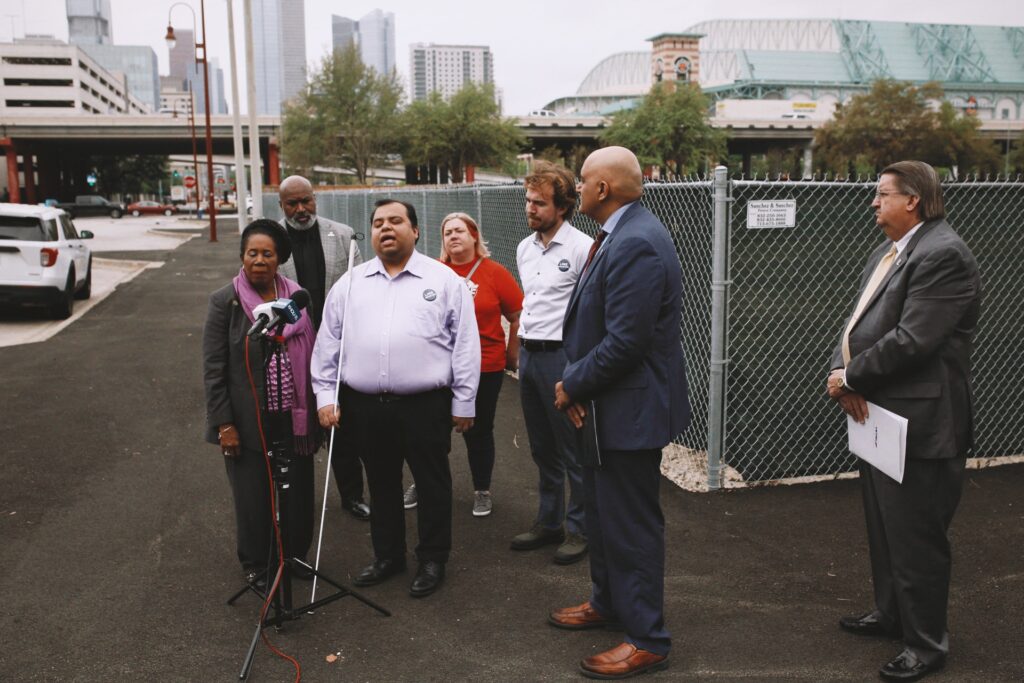The VRA: What’s in it, and LINK Houston’s Thoughts

Executive Director Gabe Cazares at the lot which used to be half of the Lofts at the Ballpark housing complex with Congresswoman Jackson-Lee, FHWA Administrator Bhatt and, METRO President Lambert.
As the Texas Department of Transportation (TxDOT) neared a ‘Record of Decision’ in early 2021 – which is the legal authority to begin the I-45 project, LINK Houston and others filed a civil rights complaint against TxDOT to the Federal Highway Administration (FHWA). FHWA accepted this complaint, began an official investigation, and instituted a pause on all design, construction, and property acquisition work while the investigation was underway. Over the past two years, FHWA has met with those who filed the complaint, other affected individuals and organizations, and TxDOT to investigate any potential violations of civil rights law. This investigation concluded on Tuesday, March 7, 2023 as FHWA announced a voluntary resolution agreement (VRA) with TxDOT. The VRA describes required actions by TxDOT in order to resolve the civil rights complaint.
What is the FHWA? What is a VRA?
Federal Highway Administration (FHWA)
The division of the United States Department of Transportation responsible for highway transportation. Provides funding, guidance, and oversight to state and local governments.
See more: About FHWA | FHWA (dot.gov)
Voluntary Resolution Agreement (VRA)
An agreement between an agency of the federal government and another agency or institution subject to federal jurisdiction. A common way to resolve civil rights complaints. Describes the specific remedial actions that the recipient will undertake to address issues identified in the investigation.
Background: Where does Houston stand with the I-45 project?
The VRA and conclusion of the civil rights investigation is the latest development in the public dialogue and political negotiations around the North Houston Highway Improvement Project (NHHIP), also known as the I-45 expansion project. Understanding the full sequence of events is essential for evaluating how well the VRA meets Houston’s expectations.
Of particular note: the VRA builds on the two Memorandums of Understanding (MOUs) that TxDOT respectively signed with the City of Houston and Harris County in December 2022. LINK Houston has summarized these here – if you need to get up to speed, this is a good place to start.
What’s in the VRA?
The VRA is 65 pages long and includes nine sections. Much of this is legalese – formal and technical language to establish the legal basis for the VRA.
The most important pieces are Section 4: TxDOT Actions, and the Timeline that TxDOT must follow to demonstrate progress on the VRA. We’ll examine both below:
TxDOT Actions
This section of the VRA describes the actions TxDOT must take to resolve the civil rights complaint and remain in good standing with the federal government.
It includes eight categories – for each, we have:
- Matched them to their related topic(s) within the City of Houston and Harris County MOUs
- Noted whether the language is NEW or SAME as what is in the MOUs
- Provided our rating and summary of the commitments
1. Reducing the NHHIP Footprint During Detailed Design
Related to:
- City of Houston topic #3
- Harris County topics #4, 5
SAME Language – Potential Loss, Potential Win
This section repeats the same weak and unclear terms from the City of Houston MOU. However, as we will explain later in this article, the VRA will be monitored by the federal government – and they do not need to take TxDOT at their word.
2. Displacements, Relocations, Housing, and Other Community Impacts
Related to:
- City of Houston topic #1
- Harris County topics #4, 5
NEW Language – Win
For those who are displaced and relocated, there are many new commitments to ensure more equitable treatment. TxDOT is required to provide more transparency about who may be displaced and when, to provide more options for where they can be relocated, and to allow residents to remain in their homes until construction begins. TxDOT is required to post this information to a new website by Thursday, April 6, 2023.
This is still a Potential Loss
This section does not make any commitments to ensure fewer people are displaced than currently proposed – that will rely entirely on reducing the footprint.
3. Flooding
Related to:
- City of Houston topic #2
- Harris County topics #3, 7
SAME Language – Win
This section repeats the strong commitments from the Harris County MOU.
4. Air Quality Mitigation
Related to:
- City of Houston topic #7
- Harris County topic #9
SAME Language – Potential Loss
This section repeats commitments from the Harris County MOU. While additional air monitoring will be helpful, the overall outcome for adjacent communities will remain inequitable.
5. Structural Caps
Related to:
- City of Houston topic #6
- Harris County topic #6
MODIFIED Language – Potential Loss, Potential Win
TxDOT commits to assist in improving public spaces on freeway caps but does not commit additional funds.
6. Parks, Open Space, Trails, and Pedestrian and Bicycle Facilities
Related to:
- City of Houston topics #5, 6
- Harris County topics #1, 2, 6, 8
NEW Language – Mostly Win
There are many new commitments and details here. TxDOT commits to a 1:1 replacement of greenspace at Kelly Village, and will provide an additional $1.5 million to the City’s Parks and Recreation Department. TxDOT has also provided more details on how connections along White Oak Bayou will be retained, and new connections on Little White Oak Bayou will be added – and formally committed to fund them.
7. Access During Construction
Related to:
- City of Houston topic #5
- Harris County topic: #2
NEW Language – Mostly Win
There are many new commitments to ensure access to schools before and after construction. TxDOT will attempt to minimize METRO disruptions but does not make any firm commitments.
8. Meaningful Access for Persons with Limited English Proficiency (LEP)
New topic – mentioned only briefly in City of Houston and Harris County MOUs
NEW Language – Win
There are many new detailed commitments to ensure multilingual engagement.
Timeline
The final page of the document is a timeline of required actions by TxDOT and their due date. You can view the full timeline , but the key dates are as follows:
Thursday, April 6, 2023 TxDOT will establish a publicly available project-specific website
This website will contain the additional required information about displacements and relocations.
Friday, August 4, 2023 TxDOT provides first Report on Compliance with LEP Survey of Displaced Individuals
Sunday, September 3, 2023 TxDOT will submit progress reports to FHWA
(and every 6 months afterwards)

Director of Policy and Planning Peter Eccles, AICP.
LINK Houston’s Thoughts
Hi there. I am Peter Eccles, LINK Houston’s Director of Policy & Planning.
I am here to speak on the current state of the I-45 project, our impression of the VRA, and how LINK Houston and other advocates can hold TxDOT accountable moving forward.
I will make four points.
- This is still an inequitable project. With this VRA, FHWA has provided tools that may address these inequities, but the project as currently proposed will leave black and brown communities shouldering most of its burdens. This is TxDOT’s project, not FHWA’s, and the VRA reflects what FHWA believes is the best of their ability to change elements of the project without fundamentally changing the project itself.
- With that caveat, the VRA broadly aligns with what the City of Houston, Harris County, and community groups have asked of TxDOT. It largely mirrors the two MOUs, while going farther in certain areas. These include:
- Displacements and relocations: TxDOT is required to provide more transparency about who may be displaced and when, to provide more options for where they can be relocated, and to allow residents to remain in their homes until construction begins.
- Neighborhood connections: There is much more detail about retaining safe walking and rolling routes across the freeway – both during and after construction.
- Community engagement: TxDOT is required to have public meetings every six months and will be held to higher standards of language access.
- On the most critical issues, the VRA is open-ended. As in the MOUs, TxDOT commits to “evaluating reasonable opportunities to reduce the project footprint in ways that would not compromise the integrity and functionality of the purpose and need of the project.” This is hardly a commitment at all, and I worry that language this ambiguous may let TxDOT off the hook. However, this ambiguity will be the battleground moving forward – especially now that FHWA will have the final say. The purpose and need (as described in the NHHIP Record of Decision) is similarly ambiguous – it mentions capacity, safety, and other broad factors, but it does not prescribe a specific width or number of lanes. The City’s re-visioning process has already demonstrated it is entirely possible to meet this purpose and need while remaining almost entirely within the existing footprint. The onus will be on the City, the County, and advocates like LINK Houston to demonstrate to FHWA how the purpose and need can be fulfilled with an alternative design.
- The VRA has the backing of the federal government. Unlike the MOUs, which are non-binding agreements with subordinate governments, the VRA will be overseen by an agency that has real authority over TxDOT. The FHWA will require TxDOT to submit progress reports every six months. If TxDOT’s progress is not to their satisfaction, FHWA has the power to force the issue: to put another pause on the project, or even to involve the Department of Justice.
Conclusion
With this VRA, the federal government has provided the strongest tools yet for local officials to work towards a more equitable project. Still, achieving meaningful progress on the most critical community demands – narrowing the footprint, improving transit access, and more – remains to be seen. This project is already on a much better course thanks to communities and local officials flexing their collective power over the past 5+ years. That work continues as TxDOT and other local agencies put the VRA into action, and as the FHWA enforces their progress. LINK Houston remains committed to ensuring the eventual project is transformational and reflects Houston’s ambition and commitment to equity and justice. We will continue to be vigilant to ensure every action in the VRA is achieved to the highest possible standard.